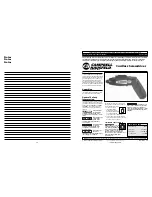
AL125UL Series
- 3 -
Installation Instructions:
The units should be installed in accordance with article 760 of The National Electrical Code and NFPA 72 as
well as all applicable Local Codes.
See Terminal Identification Chart on page 3 for a description of each terminal function.
1. Mount unit in the desired location. Mark and predrill holes in the wall to line up with the top two keyholes
in the enclosure. Install two upper fasteners and screws in the wall with the screw heads protruding. Place
the enclosure’s upper keyholes over the two upper screws; level and secure. Mark the position of the lower
two holes. Remove the enclosure. Drill the lower holes and install two fasteners. Place the enclosure’s upper
keyholes over the two upper screws. Install two lower screws and make sure to tighten all screws
(Enclosure Dimensions, pgs. 7-8). Secure green wire lead to the earth ground.
2. Power connections:
a.
AL125UL, AL125ULX: Connect 115VAC 50/60Hz to the black and white flying leads of the transformer.
Use 18 AWG or larger for all power connections (Battery, AC input, DC outputs).
Use 22 AWG to 18 AWG for power-limited circuits (Trigger inputs, Dry outputs, DC outputs).
b.
AL125ULE, AL125ULP: Connect 24VAC from UL Listed 40VA plug-in transformer (included with
AL125ULP) to terminals marked [XFMR].
Keep power-limited wiring separate from non power-limited wiring (115VAC, 50/60Hz Input,
Battery Wires). Minimum 0.25” spacing must be provided.
CAUTION: Do not touch exposed metal parts. Shut branch circuit power before installing or servicing
equipment. There are no user serviceable parts inside. Refer installation and servicing to qualified
service personnel.
3.
Measure output voltage before connecting any devices to ensure proper operation.
Improper or high voltage will damage these devices.
4. Set the desired DC output voltage by setting switch SW2 (Fig. 1a - Application Diagram, pg. 5) to the
appropriate position (Power Supply Output Specifications Table, pg. 2).
5. Connect Fail-Safe locking devices to the terminals marked [COM –] and [LOCK+]. Connect Fail-Secure
locking devices to the terminals marked [COM –] and [] (Fig. 1 - Application Diagram, pg. 5).
6. Connect normally open access control device (i.e. card reader, request to exit device, access control system)
to the terminals marked TRG INPUT [NO, GND] (Fig. 1 - Application Diagram, pg. 3).
7. Connect FACP interface to the terminals marked [FACP1 and FACP2]. Wire the 2.2K resistor (supplied) in
series for a normally closed input or in parallel for a normally open input (Fig. 1 - Application Diagram, pg. 5).
If required, set the latching FACP interface mode by turning SW1 ON (Fig. 1a - Application Diagram, pg. 5)
and connect a normally open reset device to the terminals marked RESET [NO, GND].
Note: If 2.2K resistor is not installed unit will be in alarm condition.
8. Connect battery to terminals marked [+ BAT –] (battery leads included).
Use two (2) 12VDC batteries connected in series for 24VDC operation.
Note: For Access Control applications batteries are optional.
When batteries are not used, a loss of AC will result in the loss of output voltage.
When the use of stand-by batteries is desired, they must be lead acid or gel type.
9. Please ensure that the cover is secured with the provided cam lock.
Terminal Identification:
Terminal Legend Function/Description
XFMR
Low voltage transformer connections.
+ AUX –
Aux. power output terminals. These terminals supply 12VDC or 24VDC not affected by
trigger, reset or fire alarm interface.
LOCK +
COM –
Switched power output. Fail-Safe [LOCK +] supplies positive power when unit is not
triggered and FACP interface is inactive. Fail-Secure [] supplies positive power
when unit is triggered and/or fire alarm interface is activated.
[COM –] supplies negative power.
FACP1
FACP2
Supervised by 2.2K end of line resistor FACP interface. Short or open will cause power to be
dropped to terminal marked [LOCK +] and supply power to terminal marked [].
Condition can be maintained even after restoration of the circuit (latching mode).
TRG INPUT
NO, GND
Short between these two terminals will cause power to be dropped to the terminal marked
[LOCK+] and supplied to the terminal marked [].
RESET
NO, GND
Momentary short between these terminals would end latching FACP interface condition.
Feature active only if latching FACP is selected (SW1 ON).
+ BAT –
Stand-by battery connections.
Summary of Contents for AL125UL Series
Page 6: ...6 AL125UL Series Notes...


























